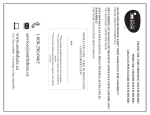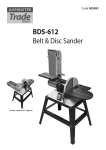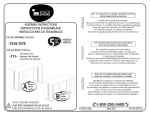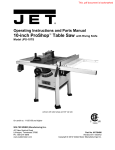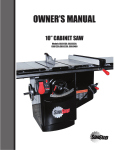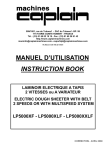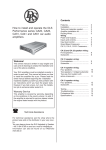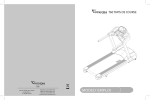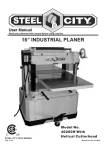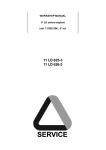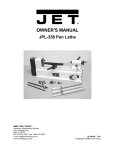Download General International 50-SLT40P Use and Care Manual
Transcript
SETUP & OPERATION MANUAL FEATURES The table rides on 14 sealed, steel ball bearing rollers and is supported by architectural grade heavy-duty steel tubing. Easy to adjust, extruded aluminum miter fence for accurate miters from 0° to 45°. Adaptable to virtually all 10-14” table saws. SLIDING TABLE SLIDING TABLE ONLY TABLE SAW SOLD SEPARATELY New design sliding quick mount bracket for added cutting capacity. Cut up to 49”* with the crosscut fence positioned at the rear. Crosscut or miter up to 28”* with the fence at the front of the table. Quick connect mounting bracket allows for easy removal of the sliding table from the saw for users with space/storage limitations. Positive stop rail and locator pin quickly sets fence for commonly used miter angles. SPECIFICATIONS WORKING FLOOR SPACE (FRONT TO REAR) 78” (1980 MM) WORKING FLOOR SPACE (TO LEFT OR RIGHT OF SAW) 30” (762 MM) WIDTH OF SLIDING TABLE 26” (661 MM) LENGTH OF SLIDING TABLE 30” (762 MM) DISTANCE IN FRONT OF BLADE TO CUT AT 90°* 28” (711 mm) DISTANCE FROM REAR OF BLADE TO CUT AT 90°* 49” (1245 MM) LENGTH OF FENCE 54” (1372 MM) MODEL #50-SLT40P LENGTH OF FENCE WITH EXTENSION STOP 91” (2311 MM) WEIGHT 133 LBS (60.5 kg) * Depending on the positioning of the mounting bracket on your saw. REVISION 2 - DECEMBER 03/10 © Copyright General® International 12/2010 GENERAL® INTERNATIONAL 8360 Champ-d’Eau, Montreal (Quebec) Canada H1P 1Y3 Telephone (514) 326-1161 • Fax (514) 326-5555 • www.general.ca THANK YOU for choosing this Excalibur by General® International model 50-SLT40P Sliding Table. This sliding table has been carefully tested and inspected before shipment and if properly used and maintained, will provide you with years of reliable service. For your safety, as well as to ensure optimum performance and trouble-free operation, and to get the most from your investment, please take the time to read this manual before assembling, installing and operating the unitting the unit. The manual’s purpose is to familiarize you with the safe operation, basic function, and features of this sliding table as well as the set-up, maintenance and identification of its parts and components. This manual is not intended as a substitute for formal woodworking instruction, nor to offer the user instruction in the craft of woodworking. If you are not sure about the safety of performing a certain operation or procedure, do not proceed until you can confirm, from knowledgeable and qualified sources, that it is safe to do so. Once you’ve read through these instructions, keep this manual handy for future reference. Disclaimer: The information and specifications in this manual pertain to the unit as it was supplied from the factory at the time of printing. Because we are committed to making constant improvements, General® International reserves the right to make changes to components, parts or features of this unit as deemed necessary, without prior notice and without obligation to install any such changes on previously delivered units. Reasonable care is taken at the factory to ensure that the specifications and information in this manual corresponds with that of the unit with which it was supplied. However, special orders and “after factory” modifications may render some or all information in this manual inapplicable to your machine. Further, as several generations of this model of sliding table and several versions of this manual may be in circulation, if you own an earlier or later version of this unit, this manual may not depict your unit exactly. If you have any doubts or questions contact your retailer or our support line with the model and serial number of your unit for clarification. GENERAL® MFG & GENERAL® INTERNATIONAL WARRANTY All component parts of General® MFG, General® International and Excalibur by General International ® products are carefully inspected during all stages of production and each unit is thoroughly inspected upon completion of assembly. Limited Lifetime Warranty Because of our commitment to quality and customer satisfaction, General® MFG and General® International agree to repair or replace any part or component which upon examination, proves to be defective in either workmanship or material to the original purchaser for the life of the tool. However, the Limited Lifetime Warranty does not cover any product used for professionnal or commercial production purposes nor for industrial or educational applications. Such cases are covered by our Standard 2-year Limited Warranty only. The Limited Lifetime Warranty is also subject to the “Conditions and Exceptions” as listed below. Standard 2-Year Limited Warranty All products not covered by our lifetime warranty including products used in commercial, industrial and educational applications are warranted for a period of 2 years (24 months) from the date of purchase. General® MFG and General® International agree to repair or replace any part or component which upon examination, proves to be defective in either workmanship or material to the original purchaser during this 2-year warranty period, subject to the “conditions and exceptions” as listed below. To file a Claim To file a claim under our Standard 2-year Limited Warranty or under our Limited Lifetime Warranty, all defective parts, components or machinery must be returned freight or postage prepaid to General® International, or to a nearby distributor, repair center or other location designated by General® International. For further details call our service department at 1-888949-1161 or your local distributor for assistance when filing your claim. Along with the return of the product being claimed for warranty, a copy of the original proof of purchase and a “letter of claim” must be included (a warranty claim form can also be used and can be obtained, upon request, from General® International or an authorized distributor) clearly stating the model and serial number of the unit (if applicable) and including an explanation of the complaint or presumed defect in material or workmanship. CONDITIONS AND EXCEPTIONS: This coverage is extended to the original purchaser only. Prior warranty registration is not required but documented proof of purchase i.e. a copy of original sales invoice or receipt showing the date and location of the purchase as well as the purchase price paid, must be provided at the time of claim. Warranty does not include failures, breakage or defects deemed after inspection by General® MFG or General® International to have been directly or indirectly caused by or resulting from; improper use, or lack of or improper maintenance, misuse or abuse, negligence, accidents, damage in handling or transport, or normal wear and tear of any generally considered consumable parts or components. Repairs made without the written consent of General® Internationallwill void all warranty. TABLE OF CONTENTS SAFETY RULES . . . . . . . . . . . . . . . . . . . . . . .5 FINE TUNING ADJUSTMENTS . . . . . . . . . . . . .16 IDENTIFICATION OF MAIN PARTS AND COMPONENTS . . . . . . . . . . . . . . . . . . . . . . .6 UNPACKING . . . . . . . . . . . . . . . . . . . . . . . .7 List of contents . . . . . . . . . . . . . . . . . . . . . . . . . . . . . .7 Additional requirements for set up . . . . . . . . . . . . .7 PREPARATION BEFORE ASSEMBLY . . . . . . . . . .8 Remove table left extension wing, rip fence and guide rails . . . . . . . . . . . . . . . . . . . . . . . . . . . . . .8 Leveling the sliding table with the saw table . . . .16 Setting the sliding table tracking . . . . . . . . . . . . . .16 Squaring the cross cut fence to the blade . . . . .18 Set the 90º stop with the fence in the front position . . . . . . . . . . . . . . . . . . . . . . . . . . . . . . . . . . .19 Set the 90º stop with the fence in the rear position . . . . . . . . . . . . . . . . . . . . . . . . . . . . . . . . . . .20 BASIC OPERATIONS . . . . . . . . . . . . . . . . . . .21 Setting and using the sliding scale . . . . . . . . . . . .21 Check points . . . . . . . . . . . . . . . . . . . . . . . . . . . . . .23 Panel cutting . . . . . . . . . . . . . . . . . . . . . . . . . . . . . .23 Miter cuts . . . . . . . . . . . . . . . . . . . . . . . . . . . . . . . . . .25 STEP 1 - LEGS AND BRACKET PRE-ASSEMBLY . . .8 USAGE TIPS . . . . . . . . . . . . . . . . . . . . . . . .25 STEP 2 - BRACKETS AND INNER RAIL INSTALLATION . . . . . . . . . . . . . . . . . . . . . . .9 Attach the main mounting bracket to the saw table . . . . . . . . . . . . . . . . . . . . . . . . . . . . . . . . . . . . . .9 Attach the quick mount bracket . . . . . . . . . . . . . . .9 Attach the rear inner leg mount to the inner guide rail . . . . . . . . . . . . . . . . . . . . . . . . . . . . . . . . . .10 Attach the inner guide rail to the quick mount bracket . . . . . . . . . . . . . . . . . . . . . . . . . . . . .10 Install the switch mount bracket . . . . . . . . . . . . . .10 STEP 3 - CROSS BRACES INSTALLATION . . . . .11 Install the cross braces . . . . . . . . . . . . . . . . . . . . . .11 STEP 4 - TABLE AND FENCE INSTALLATION . . . .11 Install the sliding table . . . . . . . . . . . . . . . . . . . . . .11 Bearing adjustments . . . . . . . . . . . . . . . . . . . . . . . .12 Install the angle adjustment rail . . . . . . . . . . . . . .13 Cross cut fence assembly . . . . . . . . . . . . . . . . . . .14 RECOMMENDED OPTIONAL ACCESSORIES . . . .26 PARTS LIST AND DIAGRAMS . . . . . . . . . .27 - 31 CONTACT INFORMATION . . . . . . . . . . . . . . . .32 Rules for Safe Operation To help ensure safe operation, please take a moment to learn the machine’s applications and limitations, as well as potential hazards. General International disclaims any real or implied warranty and hold itself harmless for any injury that may result from the improper use of it’s equipment. 1. Do not operate the saw when tired, distracted, or under the effects of drugs, alcohol or any medication that impairs reflexes or alertness. 2. The working area should be well lit, clean and free of debris. 3. Keep children and visitors at a safe distance when the saw is in operation; do not permit them to operate the saw. 4. Childproof and tamper proof your shop and all machinery with locks, master electrical switches and switch keys, to prevent unauthorized or unsupervised use. 5. Stay alert! Give your work your undivided atten tion. Even a momentary distraction can lead to serious injury. 6. Fine particulate dust is a carcinogen that can be hazardous to health. Work in a well-ventilated area and whenever possible use a dust collector and wear eye, ear and respiratory protection devices. 7. Do not wear loose clothing, gloves, bracelets, necklaces or other jewelry while the saw is in operation. Wear protective hair covering to contain long hair and wear non-slip footwear. 8. Be sure that adjusting wrenches, tools, drinks and other clutter are removed from the machine and/or the feed table surface before operating. 9. Keep hands well away from the blade and all moving parts. Use a brush, not hands, to clear away chips and dust. 10. Be sure that the blade is securely installed and in proper cutting direction before operation. 11. Be sure the blade has gained full operating speed before beginning to cut. 12. Always use a clean, properly sharpened blade. Dirty or dull blades are unsafe and can lead to accidents. 13. If using a power feeder, stop the feeder before stopping the table saw. 15. Use suitable support when cutting stock that does not have a flat surface. Always hold stock firmly against the fence when ripping, or against the miter gauge when cross-cutting. 16. To minimize risk of injury in the event of workpiece kickback, never stand directly in-line with the blade or in the potential kickback path of the work piece. 17. Avoid working from awkward or off balance positions. Do not overreach while cutting; keep both feet on floor. Never lean over or reach over the blade and never pull the work piece over the blade from behind. Use out feed support or have an assistant help when ripping long material. 18. Keep blade guards in place and in working order. If a guard must be removed for maintenance or cleaning, be sure it is properly reattached before using the tool again. 19. Never leave the machine running with the power on when not in operation. 20. Use of parts and accessories NOT recommended by GENERAL® INTERNATIONAL may result in equipment malfunction or risk of injury. 21. Never stand on machinery. Serious injury could result if the tool is tipped over or if the blade is unintentionally contacted. 22. Always disconnect tool from power before servicing or changing accessories such as blades, or before performing any maintenance, cleaning or adjustments, or if the machine will be left unattended. 23. Make sure that switch is in "OFF" position before plugging in the power cord. 24. Make sure the tool is properly grounded. If equipped with a 3-prong plug it should be used with a three-pole receptacle. Never remove the third prong. 25. Do not use this sliding table for other than its intended use. If used for other purposes, GENERAL® INTERNATIONAL disclaims any real implied warranty and holds itself harmless for any injury, which may result from that use. 14. Do not push or force stock into the blade. The saw will perform better and more safely when working at the rate for which it was designed. 5 SLIDING TABLE 50-SLT40P IDENTIFICATION OF MAIN PARTS AND COMPONENTS RAIL & BRACE ASSEMBLY MAIN MOUNTING BRACKET QUICK MOUNT BRACKET CROSS BRACE (3X) FRONT OUTSIDE BRACKET (2X) INNER GUIDE RAIL REAR INSIDE BRACKET FENCE STORAGE BRACKET (2X) SUPPORT LEG (3X) LEVELING FOOT (3X) OUTER GUIDE RAIL TABLE & CROSS CUT FENCE ASSEMBLY CROSS CUT FENCE MITER CLAMP SLIDING FLIP-UP STOP ANGLE ADJUSTMENT RAIL RETURN HANDLE SLIDING TABLE 6 UNPACKING Carefully unpack and remove the unit and its components from the box and check for missing or damaged items as per the list of contents below. BOX 1 - FENCE & RAILS NOTE: Please report any damaged or missing items to your GENERAL® INTERNATIONAL distributor immediately. LIST OF CONTENTS QTY BOX 1 - FENCE & RAILS OUTER GUIDE RAIL . . . . . . . . . . . . . . . . . . . . . . . . . . . .1 INNER GUIDE RAIL . . . . . . . . . . . . . . . . . . . . . . . . . . . .1 FENCE WITH FENCE EXTENSION POST . . . . . . . . . . . .1 ANGLE ADJUSTMENT RAIL WITH RETURN HANDLE . . .1 BOX 2 - TABLE & OTHER COMPONENTS BOX 2 - TABLE & OTHER COMPONENTS TABLE ASSEMBLY . . . . . . . . . . . . . . . . . . . . . . . . . . . . .1 QUICK MOUNT BRACKET . . . . . . . . . . . . . . . . . . . . . .1 MAIN MOUNTING BRACKET . . . . . . . . . . . . . . . . . . . .1 SLIDING FLIP-UP STOP ASSEMBLY . . . . . . . . . . . . . . . .1 ROLLER BEARING ASSEMBLY . . . . . . . . . . . . . . . . . . . .2 FENCE PIVOT PIN ASSEMBLY . . . . . . . . . . . . . . . . . . . .1 SUPPORT LEG . . . . . . . . . . . . . . . . . . . . . . . . . . . . . . . .3 CROSS BRACE . . . . . . . . . . . . . . . . . . . . . . . . . . . . . . .3 OUTSIDE BRACKET . . . . . . . . . . . . . . . . . . . . . . . . . . . .2 REAR BRACKET . . . . . . . . . . . . . . . . . . . . . . . . . . . . . . .1 RATCHET LEVER . . . . . . . . . . . . . . . . . . . . . . . . . . . . . .1 MITER CLAMP ASSEMBLY . . . . . . . . . . . . . . . . . . . . . . .1 T-NUT . . . . . . . . . . . . . . . . . . . . . . . . . . . . . . . . . . . . . . .1 SWITCH MOUNT BRACKET . . . . . . . . . . . . . . . . . . . . . .1 FENCE EXTENSION STOP MOUNT . . . . . . . . . . . . . . . .1 5 MM T-HANDLE ALLEN WRENCH . . . . . . . . . . . . . . . .1 6 MM T-HANDLE ALLEN WRENCH . . . . . . . . . . . . . . . .1 MOUNTING HARDWARE/FASTENER KIT For your convenience, the mounting hardware for the sliding table assembly is packaged into 4 separate bags identified 1, 2, 3 and 4, respectively. For each main assembly step in this manual, the bag containing the required hardware will be indicated. HARDWARE ADDITIONAL REQUIREMENTS FOR SET UP • 10/13/14 mm open end & or socket wrench • Machinist square BAG 1 BAG 2 BAG 3 BAG 4 • Phillips Screwdriver • Measuring tape • Level 7 PREPARATION BEFORE ASSEMBLY VERY IMPORTANT! BEFORE PROCEEDING WITH THE ASSEMBLY STEPS MAKE SURE THE SAW TABLE IS LEVELED WITH THE FLOOR, PLACING A LEVEL ON THE TABLE. USE SHIMS (OR LEVELING FEET IF APPLICABLE) FOR LEVELING IF NEEDED. REMOVE TABLE LEFT EXTENSION WING, RIP FENCE AND GUIDE RAILS For most installations, in order for the sliding table to be as close as possible to the blade the table extension wing must be removed. To avoid interfering with the movement of the sliding table, the rip fence guide rails will also need to be temporarily removed and may need to be shortened so that they do not protrude beyond the end of the main table. 1. Make a reference mark on the rip fence guide rails even with the end of the main table (not the extension wing and then remove and set aside the fence and rails . 2. Remove the left extension wing table and set it aside. from the main Note: Do not cut the fence rails just yet - wait until you are ready to re-install the fence after assembling, installing and aligning the sliding table. Some fence systems may allow you to simply slide or re-mount the guide rails further to the right, allowing you to increase the rip cutting capacity of the saw to the right of the blade. STEP 1 - LEGS AND BRACKET PRE-ASSEMBLY HARDWARE BAG 1* *All mounting hardware required for Assembly Step 1 can be found in hardware bag 1. NOTE: Adjustments made during the initial set-up phase may be approximate. Once the table is assembled you will be able to make minor adjustments for leveling and fine tuning at that time. 1. Install a leveling foot , a hex nut , and a flat washer to the bottom of all three support legs , as shown in . Tip: Leave a space of approximately 1" between the feet and legs as shown in to facilitate the leveling of the sliding table with the saw table when you proceed to fine tuning adjustments later. 1” 8 CLOSE UP 2. Fit a support leg into the three brackets as shown, then tighten with two hex bolts and flat washers. 3. Install a fence storage bracket er legs as shown in . onto the two out- Tip: Select the second hole from the top of the bracket as shown in to allow room for fine tuning adjustments later. STEP 2 - BRACKETS AND INNER RAIL INSTALLATION HARDWARE BAG 2* *All mounting hardware required for Assembly Step 2 can be found in hardware bag 2. After having completed Step 2, four hex bolts and four washers will be left over. Put them aside for now. ATTACH THE MAIN MOUNTING BRACKET TO THE SAW TABLE Note: Four hex bolts and flat washers are supplied with your Sliding Table. However, if they do not thread into the mounting holes on your table, use the fasteners that were supplied with the saw to hold the extension wing in place. 1. Check to see which holes on the main mounting bracket aligns on the saw’s main table mounting holes. 1/8” 2. Secure the main mounting bracket to the main table using as many fasteners as possible, at minimum, the rear two holes of the table . Tip: For added stability, holes may be drilled into the saw table if necessary. Note: The bracket should be approximately 1/8” from the top of the table . ATTACH THE QUICK MOUNT BRACKET 1. Secure the quick mount bracket to the main mounting bracket with ALL 4 socket head cap screws and 4 washers , using the supplied 6 mm t-handle wrench , as shown in . Note: Position the quick mount bracket with the square holes towards the rear of the saw. 9 INNER RAIL UNDERSIDE VIEW - THREADED HOLES QUICK MOUNT BRACKET SWITCH MOUNT BRACKET REAR INNER LEG MOUNT INNER RAIL SIDE VIEW - ACCESS HOLES FASTENER ACCESS HOLES (X6) SLIDING TABLE BEARING ACCESS HOLES ATTACH THE REAR INNER LEG MOUNT TO THE INNER GUIDE RAIL INNER REAR LEG MOUNT 1. Using the quick mount bracket as a height gauge , adjust the height of the rear inner leg mount by finding the hole that comes closest and/or by adjusting the leveling foot , until the top of the rear inner bracket is even with the quick mount bracket . 2. Attach the rear leg mount to the inner rail using 2 hex bolts and 2 washers , aligning the leg mount with the back two threaded holes in the rail , as shown in . ATTACH THE INNER GUIDE RAIL TO THE QUICK MOUNT BRACKET INSTALL THE SWITCH MOUNT BRACKET RAIL UNDERSIDE VIEW QUICK MOUNT BRACKET Attach the inner rail to the quick mount bracket using 4 hex bolts and 4 washers . Note: Verify that the inner rail is somewhat parallel with the saw table before tightening the bolts. 10 Final installation shown for clarity only SWITCH MOUNT BRACKET Install the switch mount bracket on the front end of the inner rail as shown in , using 2 hex bolts and 2 washers . STEP 3 - CROSS BRACE INSTALLATION HARDWARE BAG 3* All mounting hardware required for Assembly Step 3 can be found in hardware bag 3. INSTALL THE CROSS BRACES 1. Attach two cross braces to the quick mount bracket and the last cross brace to the rear inside bracket as shown, using 6 shoulder bolts, flat washers and cap nuts in the assembly order shown in . 2. Using the quick mount bracket as a height gauge , adjust the height of the two outer leg mounts by finding the hole that comes closest and/or by adjusting their leveling foot, until the top of the front outer brackets are even with the quick mount bracket. Final installation shown for clarity only 3. Attach the two outside leg mounts to the cross braces as shown, using 6 shoulder bolts, flat washers and cap nuts . 4. Attach the outer rail to the leg mounts (with the wide polished surface closest to the table saw) as shown, using 4 hex bolts and washers from hardware bag 2. STEP 4 - TABLE AND FENCE INSTALLATION HARDWARE BAG 4* *All mounting hardware required for Assembly Step 4 can be found in hardware bag 4. INSTALL THE SLIDING TABLE FRONT VIEW 1. Carefully slide the table onto the rails with the bearings/scrapers in the bearing guide channel as shown in . 2. Screw the table stops into the threaded holes at each end of the outer guide rail as show in . 11 BEARING ADJUSTMENTS CLOSE UP PULL BACK TO LOCK 3. To eliminate the lateral play between the table and the outer rail, release the locking bolts on the eccentric adjusters from underside of the table. Using a 3/4” socket or wrench turn the eccentric adjusters to pre - load the bearings against the rail. DO NOT OVER LOAD the bearings to the rail. Tighten the eccentric adjusters locking bolts making sure the eccentric adjusters do not move. 4. The brake lever is also mounted on an eccentric adjuster. If needed, turn the eccentric adjuster so that the brake lever prevents the table from sliding when in the locked position. Pull back towards the operator to lock. 5. To set and maintain even spacing between the inner rail and the sliding table, insert wood or cardboard shims (1/8”- 3/16” thick) between the inner rail and the edge of the saw table at the front and the rear of the table . 6. While leaning against the outside of the table to pinch the shims in place tighten the outer rail mounting bolts on the outer brackets using a 12 mm socket and then remove the shims. TOP VIEW 7. Using the slotted holes on the outer horizontal face of the sliding table install the 2 roller bearing assemblies . 12 8. Adjust the positioning of the bearing brackets, in or out, along the slotted holes in the table to bring the bracket as close to the outside edge of the rail, without touching . Then tighten the nuts to lock the bearing brackets in place. 9. Adjust the height of the bearings in the slotted hole in their bracket so that each bearing touches the bottom edge of the guide rail, then tighten the nuts to lock the bearings in place. 10. To eliminate the vertical play between the table and the inner rail, using the 6 mm "T" handle wrench supplied , locate and release the locking bolts on the eccentric adjusters (access through holes in inner rail ). Using a 3/4” socket or wrench , turn the eccentric adjusters to pre-load the bearings against the inner rail. DO NOT OVER LOAD the bearings to the rail. Tighten the eccentric adjuster locking bolts making sure the eccentric adjusters do not move. 11. Loosen the nut on the switch mount bracket bearing then adjust the height of the bearing in its slotted hole until it just touches the underside of the sliding table, then tighten the nut to lock the bearing in place. INSTALL THE ANGLE ADJUSTMENT RAIL 1. Attach the angle adjustment rail to the outside edge of the sliding table by sliding the t-nuts into the T-slot in the adjustment rail and roughly center the rail (equal distance front to back) on the table . 2. With a square or a straightedge, verify that the angle adjustment rail is leveled with the table at both ends of the rail. Then tighten the two t-nut /hex head bolt assemblies to secure the rail to the table. 13 RAIL UNDERSIDE VIEW 3. Thread a t-nut on to one of the ratchet levers . Then slide the t-nut into the t-track , and locate the hole in the underside of the angle adjustment rail . 4. Thread a ratchet lever onto the fence pivot brackets at each end of the table. Note: This ratchet lever is used to secure the return handle. CROSS CUT FENCE ASSEMBLY 1. Sit the cross cut fence face down on the front* of the sliding table with holes facing upward. 2. Insert the plastic washer on the fence pivot post *For directional clarity "front" is used to refer to the operators side of the saw. 3. Insert the t-nut into the t-slot on the right end of the fence (closest to the saw) , then slide the pivot post approximately 12" onto the fence , and secure it with the ratchet lever . 12” 14 . 4. Side the t-nut on the miter clamp into the t-slot approximately 2' from the opposite end of the fence . 5. Fit the pivot post into the pivot post bracket . Note: The pivot post should protrude an equal distance from the top and bottom of its mounting bracket . Flush here 6. Slide the mitre clamp assembly along the fence until the t-nut lines up with the t-slot on the angle adjustment rail . If needed, adjust the height of the mitre clamp post so it is flush with the bottom of the mitre clamp bracket . 8. Install the two thumbscrews into the holes in the front face of the cross cut fence. Note: The thumbscrew is used to lock the fence extension post in place. 7. Remove the fence extension post from the end of the fence . Slide the fence extension stop mount on to the post and re-install the post in the same end of the fence . The cross cut fence may be stored on the fence storage brackets as shown above. 15 FINE TUNING ADJUSTMENTS To ensure the ability to make square and accurate repeat cuts the following fine tuning adjustment procedures should be performed after completing the assembly steps. VERY IMPORTANT! THE FOLLOWING ADJUSTMENTS WILL PROVIDE ACCURACY ONLY IF YOUR SAW TABLE IS LEVELED WITH THE FLOOR. USE SHIMS (OR LEVELING FEET IF IT HAS SOME) FOR LEVELING IF NEEDED. LEVELING THE SLIDING TABLE WITH THE SAW TABLE 1. Using a level, verify that the sliding table is leveled with the saw table . SETTING THE SLIDING TABLE TRACKING The sliding table must be set to run parallel to the blade (and not the mitre slot ) .Verify and, if needed, set the table tracking parallel to the blade as follows: Note: For the following step you will need a straightedge (a minimum of 30" long and preferably as long as possible). If you don’t own one, you can always use your saw rip fence. TURN OFF AND UNPLUG THE SAW BEFORE PERFORMING ANY ADJUSTMENTS. 16 2. If needed adjust the leveling feet on the support legs . The height of the main mounting bracket may also need to be adjusted . Note: For the following step, the cross cut fence must be set at the front of the table. 1/4” 1. Raise the table saws blade to its maximum and place the straightedge (or rip fence) against the blade. 2. Bring the sliding tape measure slide to approximately 1/4" from your straightedge 3. Slowly slide the table front to back while observing for any distance/parallel variations from the tape measure slide to the straightedge (or rip fence) , taking care not to bump or dislodge the straightedge from the blade. Note: If you observe no parallel variations from the tape measure slide to the straightedge, then the table is in fact already tracking parallel to the blade and will require no further adjustment. Proceed to the next adjustment: “Squaring the Cross Cut Fence to the Blade”. To eliminate the variation and set the table tracking parallel to the straightedge, adjustments to the outer rail will be required. If the table is tracking away from the straightedge (front to back) then the trailing end of the outer rail will need to be moved slightly in towards the saw (see next step). > 1/4” < 1/4” If the table is tracking in towards the straightedge (front to back) then the leading end of the outer rail will need to be moved slightly in towards the saw (see next step). Note: As you move either end of the outer rail in towards the saw make sure to maintain a minimum 1/16" gap between the table and the outside edge of the inner rail (see shims reference – step #5 of “Install the sliding table”, on page 12. 17 RAIL UNDERSIDE VIEW 4. To adjust the outer rail, loosen the 2 bolts outer leg brackets . on the 5. Manually adjust either the front or rear end of the outer rail towards the saw then retighten the leg bracket bolts. 6. Slowly slide the table front to back and verify the table tracking again. If needed, make further adjustments until the table is tracking parallel to the straightedge. SQUARING THE CROSS CUT FENCE TO THE BLADE FENCE IN FRONT POSITION 90° In order to make repeatable square cuts the crosscut fence must be set 90° perpendicular to the blade with the fence mounted in both front & rear positions. Verify and, if needed, adjust the alignment of the cross cut fence as follows for front mounted position. 1. Place a straightedge against the blade . Note: The accuracy of this adjustment will only be as good as the accuracy of the squaring tool used. A typical construction style “framing square” is not considered a precision tool and is not adequate for fine tuning type adjustments. If you do not already own one, consider contacting your local woodworking or machinist supply distributor and investing in a set of quality machinist squares that can be used for fine tuning and adjustments for virtually every machine found in a typical wood shop. 2. Place one edge of a machinists square the straightedge . 18 flush to CLOSE UP 3. Loosen the miter clamp and adjust the cross cut fence to the perpendicular face of your machinists square . Then secure the cross cut fence in position by tightening the miter clamp. 4. Adjust the sliding angle indicator (degree scale) by loosening the lock bolt and manually aligning it to “0” with the front face of the cross cut fence and then re-tighten the lock bolt. SET THE 90º STOP WITH THE FENCE IN THE FRONT POSITION The 90° stop can now be set to allow the cross cut fence to be brought back perpendicular to the blade whenever needed and without having to further realign the fence each time. To do this: 1. Loosen the 3 hex bolts . Once the 90º stop has been set, the positive stop pin can be used to locate the other holes in the positive stop rail, which corresponds to the other commonly used angles: 15º, 22.5º, 30º and 45º. 2. Slide the positive stop rail until the positive stop pin locates the 90° hole , then retighten the bolts. 45° 30° 22.5° 15° 90° To manually set an angle, first loosen the miter clamp locking levers, then slide the left end of the cross-cut fence along the angle indicator rail to the desired angle, then retighten the locking levers to securely lock the fence in position. 19 SET THE 90º STOP WITH THE FENCE IN THE REAR POSITION In order to make repeatable square cuts the crosscut fence must be set 90° perpendicular to the blade with the fence mounted in both front & rear positions. To align the cross cut fence in the rear mount position reverse the fence to rear position as follows. , TURN OFF AND UNPLUG THE SAW BEFORE PERFORMING ANY ADJUSTMENTS. 1. If installed, remove the extension from the cross-cut fence. 2. Loosen the miter clamp and slide the fence off of the angle adjustment rail. 12” 3. Lift the fence assembly off of the pivot mount and lay it face down. 4. Slide the pivot post out of the T-track on the fence and install it on the opposite side of the fence to approximately 12”, . VIEW FROM REAR 5. Swing the fence assembly around 180° and fit the pivot post into the rear pivot post bracket. 20 6. Slide the miter clamp assembly along the fence until the t-nut lines up with the t-slot on the angle adjustment rail , then tighten the pivot bracket ratchet lever to secure the fence against the table. Once the cross cut fence has been reversed to rear position, verify and, if needed, adjust the alignment of the cross cut fence for rear mounted position. You will then be able to set the 90° stop as follows, to allow the cross cut fence to be brought back perpendicular to the blade whenever needed and without having to further realign the fence each time. 1. Loosen the hex bolt block . and remove the 90° locator 2. With the fence in the rear position, using a machinists square, repeat the alignment of the fence 90° to the straightedge against the blade, then lock the miter clamp . CLOSE UP 3. Slide the 90° locator block until it meets the stop pin , then re-tighten the hex bolt. Once the assembly and all alignment steps have been completed, reinstall the rip fence system on your table saw. BASIC OPERATIONS SETTING AND USING THE SLIDING SCALE The sliding scale can be set to read left to right (from the blade onward) with the fence in either front or rear position. • With the fence mounted to the front of the table: Use the scale with the low numbers next to the blade ; • With the fence mounted to the rear of the table: 1. Loosen the locking bolt using a 10 mm . 2. Remove the sliding scale from the fence, swing it around 180° then re-install it in the same end of the fence so the low numbers will still be next to the blade . 3. Secure the sliding scale by tightening the locking bolt. 21 To set the sliding scale and permit accurate measurements using the flip stop: 1/4” 1. Set the fence to approximately 1/4" from the blade and secure it using the ratchet levers of both the miter clamp and pivot post. 2. Align the sliding scale flush to the end of the fence. 10” 3. Secure the sliding scale by tightening the locking bolt. 4. Position the sliding flip-up stop at any dimension on the scale, i.e. 10”. CLOSE UP NOTE: The sliding flip-up stop is also reversible, allowing you to orient the leading edge to best suit your work habits or personal preferences. 22 5. Draw the table to the front of the saw, providing space between the fence and the blade and place a piece of scrap material against the sliding flipup stop . VERIFY ALL FOLLOWING CHECK POINTS BEFORE TURNING ON THE SAW. FAILURE TO COMPLY CAN RESULT IN SERIOUS INJURIES. CHECK POINTS • Make sure that the arbor nut is secure and that the blade is firmly tightened snug on the arbor. • Check that the blade angle and height lock knobs are tight. • While using the saw, be sure to wear safety glasses at all times. • Make sure that the blade guard/splitter assembly is properly installed and aligned with the blade, and that the anti-kickback pawls are functioning. • Slide table front to back to make sure the fence completely clears the blade without touching. DO DO NOT 6. Turn on the saw and process the cut ensuring that the workpiece is held tight to the fence and against the stop. 7. To obtain an accurate dimension from the flip stop to the blade, measure the cut workpiece with a separate tape measure or scale. 8. Transfer this accurate dimension to the sliding scale. To do this, flip up the stop and adjust the sliding scale, aligning the dimension to the leading edge of the flip stop. 9. Lock the sliding scale in place. PANEL CUTTING With the cross-cut fence mounted on the rear of the table (rear position), you can cut a maximum cross cut of : 40"* while clearing the blade or up to 49"* without clearing the blade * Depending on the positioning of the quick mount bracket on your saw. 23 DO NOT USE RIP FENCE AS A GUIDE OR WORKPIECE STOP WHEN OPERATING THE SLIDING TABLE. TO AVOID POTENTIAL OF WORKPIECE BINDING WHICH WILL CAUSE KICKBACK, REMOVE THE RIP FENCE FROM THE SAW COMPLETELY. FENCE IN REAR POSITION 1. Set the cross-cut fence to the rear of the sliding table (Maximum capacity position). 2. Loosen the two ratchet levers 3. Slide the cross-cut fence to within 1/4" of the blade , then tighten the ratchet levers to secure the cross-cut fence so it does not move during the cut. 4. Draw the sliding table fully to the front of the saw. 1/4” 5. Load the panel onto the sliding table. 6. Adjust the sliding extension and/or flip stop if needed. 7. With the panel flush to the cross-cut fence, align the cut line on the panel with the blade. Note: For repeat cuts, set the flip stop against the opposite end of the panel and lock it in place. 8. Turn on the saw. 9. Keeping a firm forward pressure against the panel to hold it flush to the fence, walk the panel through the cut. Tip: The table return handle can be used to help maintain pressure on the workpiece against the fence as your push it through the cut. 24 . MITER CUTS FENCE IN FRONT POSITION With the cross-cut fence positioned at the front of the table (front position), you can cut a maximum of 36"* and make miter cuts from 0° to 45°. * Depending on the positioning of the quick mount bracket on your saw. NOTE: To reposition cutting capacity, slide the quick mount bracket towards the front of the saw. See the explanatory note at the bottom of this page. Loosen the miter clamp locking levers , then slide the left end of the cross-cut fence along the angle indicator rail to the desired angle and retighten the locking levers to securely lock the fence in position. To set commonly used angles: 15º, 22.5º, 30º, 45º and 90º, loosen the miter clamp locking levers and position the fence in the vicinity of the desired angle. Compress the stop pin until it seats in the hole then tighten the miter clamp locking levers. USAGE TIPS The two slots in the quick mount bracket tioning the cut capacities of this unit. are for reposi- For maximum stability, use all four socket head cap screws. The sliding table can be detached from the saw and put aside ,simply by unscrewing the 4 cap screws which secure the quick mount bracket to the main mounting bracket . 25 RECOMMENDED OPTIONAL ACCESSORIES Here are some of the optional accessories available from your local General International dealer. For more information about our products, please visit our website at www.general.ca Notes 26 SLIDING FLIP-UP WORKSTOP #50-EXSTOP HOLD DOWN CLAMP #50-EXHDC Sliding flip stop for cross cut fence on Excalibur sliding tables. Fits in the t-slot of the cross cut fence on your Excalibur sliding table. For applications where multiple repeat cuts are required, use several stops positioned where needed and flip up out of the way when not required. Hold down clamp for Excalibur sliding tables. Holds the workpiece down for consistent cuts and improved accuracy with your Excalibur sliding table. 76 71 40 40 71 67 40 71 55 68 69 71 71 40 A A B B 52 51 53 76 71 40 40 71 67 40 71 55 C D 71 E 52 51 54 53 68 69 71 40 F G H 14 40 71 10 17 18 52 51 53 52 51 53 73 56 40 71 70 10 J E 9 F 57 G 45 81 I H 46 54 47 52 51 53 52 51 53 48 C D I J 72 K L 71 77 60 52 51 54 53 79 59 40 71 49 K L 71 68 69 67 71 40 40 71 SUPPORT SYSTEM 27 2 15 11 10 20 9 97 97 11 9 18 5 17 97 13 6 7 6 18 17 10 13 10 12 11 26 10 25 9 13 8 4 6 10 3 98 18 16 21 10 13 10 13 11 7 9 22 M 60 8 15 23 18 25 19 17 26 8 99 12 10 13 9 17 10 10 18 96 17 24 10 18 18 19 10 17 58 9 10 90 19 8 18 17 18 99 7 17 10 23 10 96 60 19 22 28 1 TABLE ASSEMBLY CROSS CUT FENCE 29 PARTS LIST 50-SLT40P 30 REF. N0. PART N0. DESCRIPTION SPECIFICATION QTY 1 2 3 4 5 6 7 8 9 10 11 12 13 14 15 16 17 18 19 20 21 22 23 24 25 26 27 28 29 30 31 32 33 34 35 36 37 38 39 40 41 42 43 44 45 46 47 48 49 50 51 50SLT60-01 50SLT60-02 50SLT40P-01 50SLT60-04 50SLT60-08 50SLT60-06 50SLT60P-07 50SLT60-08 50SLT60-09 50SLT60P-10 50SLT60-11 50SLT60P-12 50SLT60-13 50SLT60P-14 50SLT60P-15 50SLT60-16 50SLT60-17 50SLT60-18 50SLT60-19 50SLT60-20 50SLT60-21 50SLT60-22 50SLT60-23 50SLT40P-02 50SLT60P-25 50SLT60P-26 50SLT60-27 50SLT60-28 50SLT60-29 50SLT60P-30 50SLT60P-31 50SLT60-32 50SLT60P-33 50SLT60P-34 50SLT60-35 50SLT60-36 50SLT60-37 50SLT60-38 50SLT60-39 50SLT60P-40 50SLT60-41 50SLT40-42L 50SLT40-43 50SLT40-44 50SLT40P-04 50SLT60-46 50SLT60-47 50SLT60-48 50SLT60-49 50SLT60-50 50SLT60-51 PLUG RETURN HANDLE SLIDING ANGLE INDICATOR ANGLE ADJUSTMENT RAIL POSITIVE STOP RAIL T NUT RATCHET LEVER ECCENTRIC NUT LOCK NUT M6X1.0P(10BX7H) FLAT WASHER 6.4X16X1.6T HEX. BOLT M6X1.0PX16 BRUSH HEX. BOLT M6X1.0PX25 HEX. BOLT M6X1.0PX30 GUIDE BEARING ASSEMBLY WAVE WASHER WW-10 BEARING 6200-2NK BUSHING CAP SCREW M6X1.0PX25 BEARING BRACKET BRAKE LEVER PAN HEAD SCREW M6X1.0PX16 PIVOT POST BRACKET TABLE CAP SCREW M5X0.8PX8 FLAT WASHER 5.2X10X1.0T FENCE EXTENSION POST FENCE EXTENSION STOP MOUNT THUMB SCREW MITER CLAMP ASSEMBLY SLEEVE SCREW M6X1.0PX16 SLIDING BRACKET FENCE PIVOT PIN ASSEMBLY SHOULDER BOLT WASHER Ø28XØ19X2T SLIDE PLATE 30X52X2T SPRING PIN 6X20 PIVOT POST BOLT M8X1.25PX16(13BX5.5H) EXTENSION BUSHING Ø12XØ6.5X25 SCALE SLIDING SCALE PLATE 15.3 X 53.5'' X 5(T) FENCE 49X64X54"L OUTER GUIDE RAIL STOP RING Ø13.5XØ4.5X5T FLAT WASHER 4.3X12X1.0T CAP SCREW M4X0.7PX12 BRACKET TAPE 3M VHB F-9473 PC T= 0.25MM FLAT WASHER 8.5X16X2.0T 1 1 1 1 1 7 4 6 8 23 7 2 11 1 2 1 14 15 6 2 1 4 2 1 4 4 1 1 2 1 1 2 2 1 1 1 1 4 1 12 1 1 1 1 1 2 2 2 1 1 12 PARTS LIST 50-SLT40P REF. N0. PART N0. DESCRIPTION SPECIFICATION QTY 52 53 54 55 56 57 58 59 60 61 62 63 64 65 66 67 68 69 70 71 72 73 76 77 79 80 81 82 83 84 85 86 87 88 89 90 91 94 95 96 97 98 99 102 50SLT60-52 50SLT60-53 50SLT40P-05 50SLTP60P-55 50SLT60-56 50SLT60P-57 50SLT60P-58 50SLT40P-06 50SLT60P-60 50SLT60-61 50SLT60-62 50SLT60-63 50-EXSTOP 50SLT60-65 50SLT60-66 50SLT60P-67 50SLT60-68 50SLT60-69 50SLT60P-70 50SLT60P-71 50SLT40P-07 50SLT40P-08 50SLT60P-76 50SLT60P-77 50SLT60P-79 50SLT60P-80 50SLT60P-81 50SLT60P-82 50SLT60P-83 50SLT60P-84 50SLT60P-85 50SLT60P-86 50SLT60P-87 50SLT60P-88 50SLT60P-89 50SLT60P-90 50SLT60P-91 50SLT60P-94 50SLT60P-95 50SLT60P-96 50SLT60P-97 50SLT60P-98 50SLT60P-99 50SLT60P-102 CAP. NUT M8X1.25P(13BX6.5H) CARRIAGE BOLT M8X1.25PX16 CROSS BRACE BRACKET HEX. BOLT M8X1.25PX20(13BX5.5H) FLAT WASHER 8.2X22X3.0T T-HANDLE ALLEN WRENCH 6MM INNER GUIDE RAIL FLAT WASHER 6.3X1.3X2.0 SHOULDER BOLT M8X1.25PX65(13BX5.5H) FLIP STOP NYLON WASHER 10X16X1.0T FLIP STOP ASSEMBLY SLIDE BLOCK LOCK NUT M8X1.25P(13BX9H) SUPPORT LEG LEVELING FOOT M6XP1.0X25 HEX. NUT M8X1.25P(13BX6.5H) QUICK MOUNT BRACKET FLAT WASHER 8.5X19X2.0T BEARING GUIDE CHANNEL SWITCH MOUNT BRACKET STORAGE HOOK CAP SCREW M8X1.25PX12 CAP SCREW M6X1.0PX8 RATCHET LEVER MAIN MOUNTING BRACKET BUTTON INDEX PIN SPRING T NUT RATCHET LEVER RATCHET LEVER INDEX PIN SEAT "S" CLIP STW-6 T-HANDLE ALLEN WRENCH 5MM RATCHET LEVER TAPE 3M VHB F-9473 PC T= 0.25MM SLIDE PLATE CAP SCREW M8X1.25P FLAT WASHER 6.6X13X1.0T 90° LOCATOR BLOCK SCRAPER O RING P14 12 12 3 2 4 4 1 1 10 1 1 2 1 1 1 3 3 3 1 17 1 1 2 4 6 1 1 1 1 1 1 1 1 1 1 1 1 1 1 2 6 1 2 1 31 MODEL 50-SLT40P 8360 Champ-d’Eau, Montreal (Quebec) Canada H1P 1Y3 Fax: (514) 326-5565 - Tel.: (514) 326-1161 Fax: (514) 326-5555 - Parts & Service / Order Desk [email protected] www.general.ca IMPORTANT When ordering replacement parts, always give the model number, serial number of the machine and part number. Also a brief description of each item and quantity desired.
































